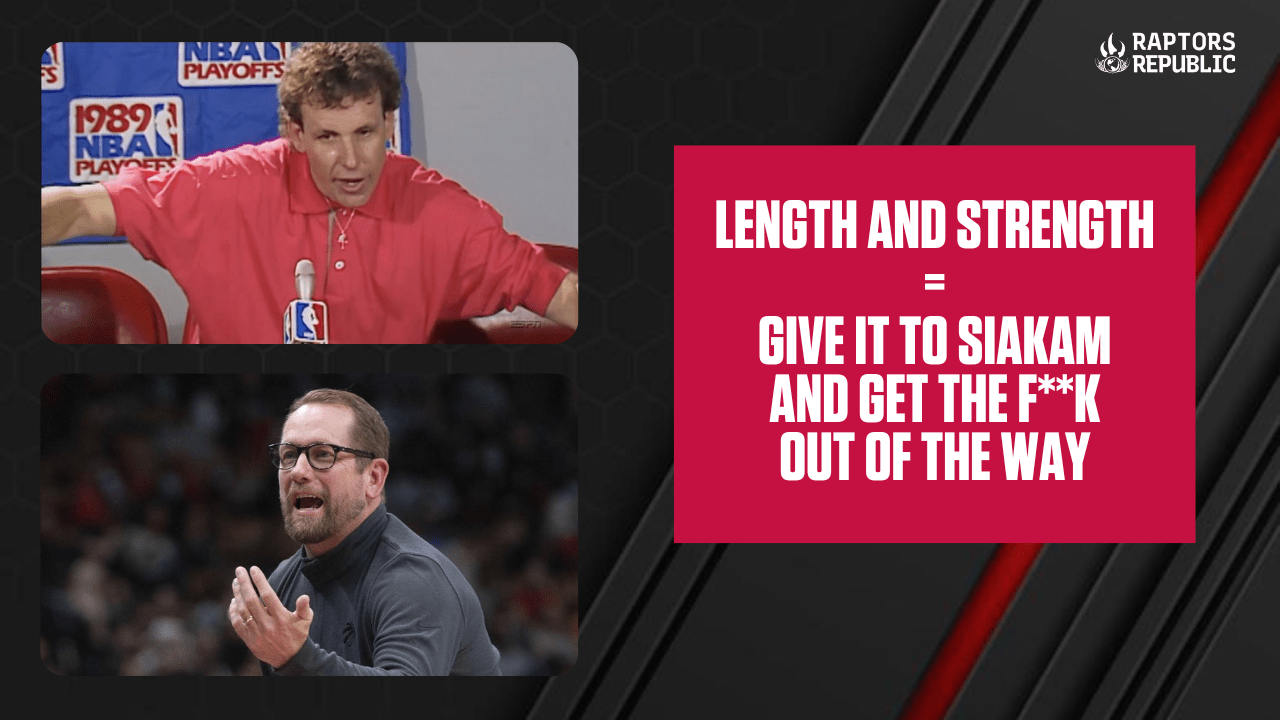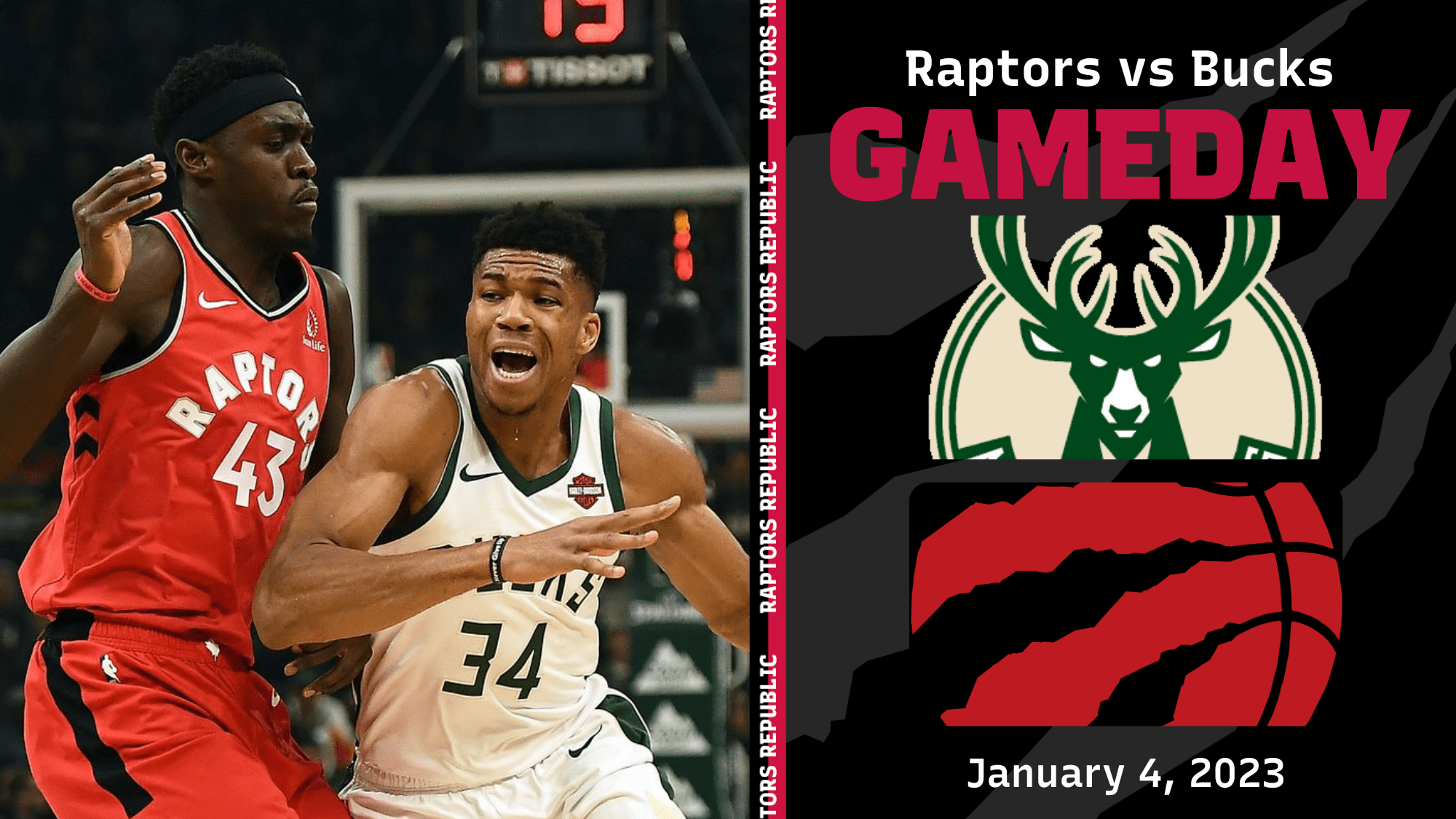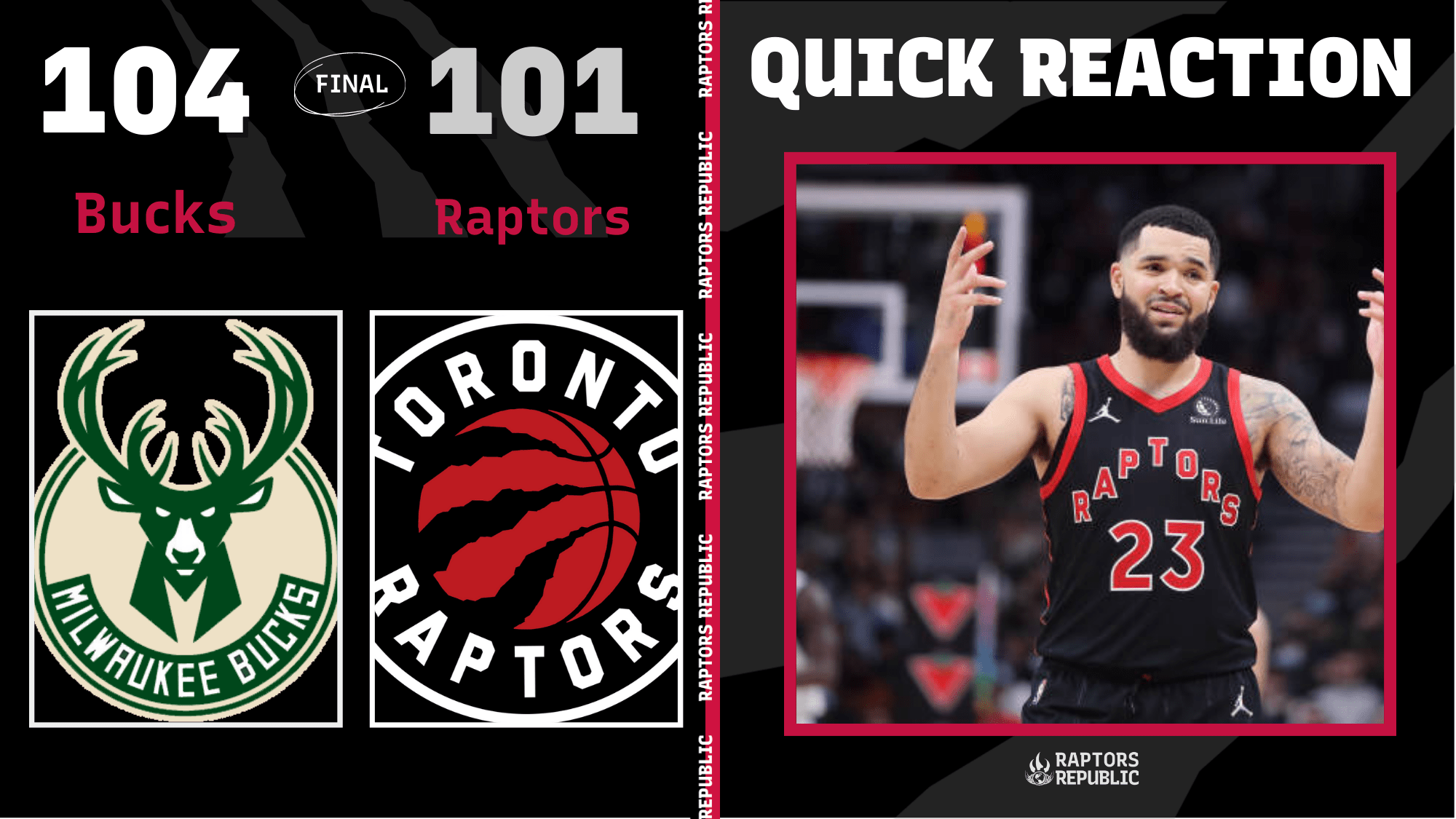What’s old is new again. In 1989 Michael Jordan hit a clutch game-winner over Craig Ehlo in Cleveland to give the Bulls the series win in the deciding game. In the post-game press conference Doug Collins famously remarked that the strategy was to give Jordan the ball and “get the f**k out of the way”. He was soon fired.
Everyone is salty and rightfully so. People had expectations of the Toronto Raptors based on the unreliable concept of “natural progression,” and those expectations have not been met. We’ve been in bridge years for thee years now, and it’s looking like the current program isn’t a bridge to a contender, but more like a Crimean bridge about to be cratered by the realization that we:
- have the wrong players in the system we are trying to play
- have the wrong system for the players we have
- have the wrong personnel regardless of what system we decide to use
- have the wrong system and no players can make it successful
The Raptors have played 37 games, which gives us enough to evaluate some of these positions. We have to start with the system which not long ago was deemed innovative and novel, when in reality it was simply different than the trendline. Not having a “traditional” point guard and replacing the center with a slender power forward who can also dribble the ball isn’t anything terribly new. The 90s Bulls didn’t have a point guard, and Kevin Garnett could be credited as pioneering the hey-look-this-power-forward-can-dribble look. However, the Raptors system was relatively different if you consider a shorter time period and make a big assumption: that the league was trending in the length-and-strength direction and the Raptors were a couple years ahead of the curve.
This hasn’t proven itself to be true. We tried to zig hoping the rest of the league would do as well, except that they zagged. Nikola Jokic, Brook Lopez, Steven Adams, Zion Williamson, Joel Embiid and Jarrett Allen are front-and-center on their respective teams, which all occupy top-10 spots in the league. In contrast, the Raptors’ center position has been a major issue for three years, and the front office has been derelict in duty. They either feel they can get by without it and make up for it with a different style of play, or have simply failed to address it despite wanting to. Not sure which is worse. Watching Khem Birch, Precious Achiuwa and Christian Koloko getting overrun hasn’t been fun, I think we can all agree with that. It may be better than Aron Baynes or Alex Len, but functionally the result has been mostly the same.
Transitioning from the reliable Kyle Lowry to a combination of Pascal Siakam, Fred VanVleet and whoever on the day thinks they can play point guard has been amusing to watch. Siakam has done his part and then some by increasing his scoring load while also improving his assist count by 1.4. He’s taken on the lion’s share of offensive responsibility but has had little help from the #2 on this team, VanVleet. The stocky point guard is shooting an absolutely wretched 32.7 percent from three while taking close to 9 per game, and he is getting torched defensively, most recently against Indiana in the clutch, and more prominently by Kyrie Irving at the buzzer.
The Raptors have been trying to hide VanVleet’s lack of creativity and speed for years. It was easier to do with Lowry around, and they hoped that Siakam would be able to cover it further by taking on PG duties while also converting VanVleet into a spot-up shooter. This has backfired as 1) VanVleet isn’t shooting well, making him an offensive liability, and 2) Siakam is spending much less time slashing off the ball (a great strength) since he has the ball more. This is a double-whammy which isn’t called out enough, and is made worse by the fact that the length-and-strength system demands slashing off the ball to utilize that length and strength.
If we are starting from a static position every time it negates whatever stride advantages we may have. Length means little in tight quarters. OG Anunoby, Precious Achiuwa, Pascal Siakam and Scottie Barnes all have a theoretical advantage against a shifting defense, but the Raptors never quite put the defense under enough pressure to shift because they can’t dribble penetrate consistently (because it’s usually smaller quicker players that are good at that). Add to it that the Raptors are poor at attacking close-outs, and when they do attack them the ensuing 3-pointer is missed, making you wonder just what needs to click for the Raptors to click.
The Raptors also can’t unlock set defenses because they don’t/can’t run the pick ‘n roll enough. They rank 23rd in pick ‘n roll frequency, and this is directly related to neither having a point guard who can run it nor a big man who can set effective screens for it. Bereft of this bread-and-butter play, the Raptors have to manufacture offense in isolation, of which Siakam has done a magnificent job, but it’s not enough. Offense in the modern NBA is supposed to be easy — this season is setting records for leaguewide offensive efficiency. Shooting and pick-and-roll play are a big part of that. But the Raptors make scoring look impossible (when they’re playing offense, not so much when they’re defending it). The rising tide that’s lifting all boats south of the border seems not to have mattered much when the Raptors try to score.
I laugh when people have expectations of Khem Birch in this regard, because let’s be clear, Birch is not a proven player in the league. He was barely a rotation player in Orlando yet somehow the expectations we have of him in Toronto are 10x that. Toronto’s problem is foundational, structural — Birch is about as far from a structural fix as you can get.
You’ll remember that the Raptors won a title with an extremely traditional lineup of two big men, a pure point guard, and excellent slashing led by Siakam. The switch to the current scheme is a 180 degree change, and you have to at least ask whether, given where the league is trending, it’s the right approach. And if so, what specifically needs to change for this to work? No matter what the physical characteristics of the personnel are, it’s obvious that 3-point shooting needs to improve. The Raptors are 29th in the league (the Hornets are worse). However, I don’t think it’s a question of shot-making, but one of shot-generation.
You can debate whether it’s a question of the Raptors missing clean looks or not creating good looks. If it’s a few games than you can convince me that it’s a question of cold shooting, but we’re 37 games in! OG Anunoby is at 35 percent, Trent Jr. at 36 percent, Siakam at 34 percent, Porter Jr. at 35 percent, VanVleet at 33 percent, and Barnes at 30 percent. Actual 3-point shooters like Hernangomez and Boucher are both at 28 percent. Given the sample size and prolonged period of play, maybe the Raptors aren’t actually generating clean looks, or at least the right looks for the personnel they have, which points to a system issue more than a Sam Mitchellesque “more shats” problem.
We also have to question whether Nurse and management are on the same page, mostly because the Raptors don’t have a bench, and coaches generally like having benches. Asking Nick Nurse to win games with a non-traditional lineup with no bench is asking him to perform alchemy that is beyond his, or any, coach’s powers. Nurse will do what Nurse knows how to do: grind his productive players and keep searching for answers by trying different things. I’m not sure he can do much with this lineup. Sure, he can pull Boucher in and out of the lineup, swap out Koloko for Hernangomez with the starters, but all that is small fries. These aren’t going to result in material and sustainable improvements that alter the course of the season. The lineup has changed, but the problems have remained the same.
Nurse appears to be struggling just like the rest of us in trying to figure out what works, and we’re running out of things to try. In the process of his lineup experimentation we’re seeing a team that is supposed to be the better defensive team on account of their size and wingspan become a bottom-third defensive team (ranked 21st). What was indisputably supposed to be our strength has turned into our weakness. Try to explain that at a New Years Eve party when you’re supposed to be the guy writing for a Raptors site.
Naturally, when reality doesn’t meet expectations, we tend to hit the panic button, and on the distant horizon we see the tank mob taking shape. Emboldened by the Tampa season, the troops are taking their positions and calibrating their weaponry. The problem is that I’m not sure what a successful tank even buys us. Another top pick? Well, we got the best-case version of that with Scottie Barnes, and here we are longing for another tank after a small taste of success and then a plummet back down into the dumps? Doesn’t seem right. Losing can beget more losing, and the Raptors are flirting with that dangerous line.
There are two types of tanking. First is the invested tank like Philadelphia went through, a long-term strategy of losing to accumulate picks. Second is the short-term tank where you give up on a season to get a high pick. It’s a surgical tank more than a strategic one. In both cases there is a divesting of mature assets for younger ones. The former is out of the question, and the latter seems to be going down a road of hope more than conviction. Did the Raptors not already accomplish the latter, relatively successfully? One thing I do agree with is that a change in personnel is in order.
First up, Pascal Siakam is going nowhere and should be evaluated in the summer based on the strategic direction of the franchise. He is by far the highest value asset the Raptors have if they are looking to aim for a Scottie Barnes-led contention window 3-4 years down the line. Come summertime, it might just be that it’s Siakam who feels this isn’t the right situation for him in terms of winning. The Raptors should not touch Siakam, and instead they should make an effort to surround him with the talent that elevates him even further, not shove more responsibility on him just because there’s no one else to do it.
Siakam is becoming so good that we should be officially talking about wasting his talent by not having the right team around him. Unlike Chris Bosh who moped out of here because of similar reasons, Siakam will probably afford the Raptors more leeway, but eventually good will runs out.
Second, if we are sticking with length-and-strength, then Fred VanVleet has to go. He’s been the odd man out for a while, and given that he’s reduced his own role on the team to a spotty spot-up shooter, his minutes don’t yield what they should for the system to be successful. If we’re looking for shooting (which we totally should be), there are cheaper options that don’t demand the shots Fred does. He’s a free agent (player option) this summer and the Raptors absolutely cannot lose him for nothing. That would be sacrilegious, and a continuation of some of the asset losses that put Toronto in this situation after the championship, so Fred should be traded with a 21-gun salute. He deserves one of the best video tributes in franchise history, but it better be as an opponent.
Third, Gary Trent Jr. seems to be on the trading block constantly, and I’m not sure why. People tend to confuse the Raptors’ lack of shooting guard depth as an indictment on Trent, when it speaks to management more than the player. He’s young enough to fit with a “Barnes-era” team, is shooting a career-high FG percentage and seems to be one of the few Raptors who can pressure the defense (e.g., by attacking a close-out and having his shot respected enough). The problem with Trent Jr. is that his contract runs out this summer (another player option), except I’m completely open to re-signing him to a fair contract.
Fourth, OG Anunoby should be going nowhere because no matter what the Raptors do, they’ll have a need for a player like him. Every team in the association does. He’s not going to be a superstar, but he will always be a valuable component of whatever scheme any coach will want to execute. A defensive stalwart who can score in spots and doesn’t demand the ball, all at a reasonable salary, is something to hang on to.
Fifth, the Raptors have a collection of pretty mediocre players on the bench: Malachi Flynn, Hernangomez, Dalano Banton, Boucher, Birch etc. These bench spots are producing little and contributing the most to the overall malaise around these parts. Otto Porter Jr. was a nice little add but due to injury hasn’t been able to really join the team, but the rest of them should have to earn their minutes back. If I had to make a trade at the deadline and had to pick one thing, I would beef up this unit by adding shooting and ball-handling (even more so than a big man) just to relieve the pressure on Siakam to make plays.
The above equate to surgical fixes, but what if the problem is with the philosophy rather than the personnel executing the philosophy? Abandoning length-and-strength may seem tempting but what is preventing me from hitting the reset button is that the Raptors never put together a roster that was capable of implementing it honestly. It seems like we threw together a bunch of lengthy guys and expected that act of assembling them to be the advantage. Other teams aren’t dumb and if fans can see plainly through the disjointed offense, the porous defense, the lack of outside shooting, and most importantly, the heavy reliance on Siakam to do just about everything, so can they.
This is less of a team and more of a Siakam show because the front office has, for the third year in a row, failed to assemble a roster to support the core strengths of its key player and self-professed philosophy. It’s irrelevant what style we want to play if the players aren’t there to support that style. If the franchise decides to stay the course or change to what’s been a proven formula for winning (even in Toronto), one thing has to change: the front office needs to start doing its job.




